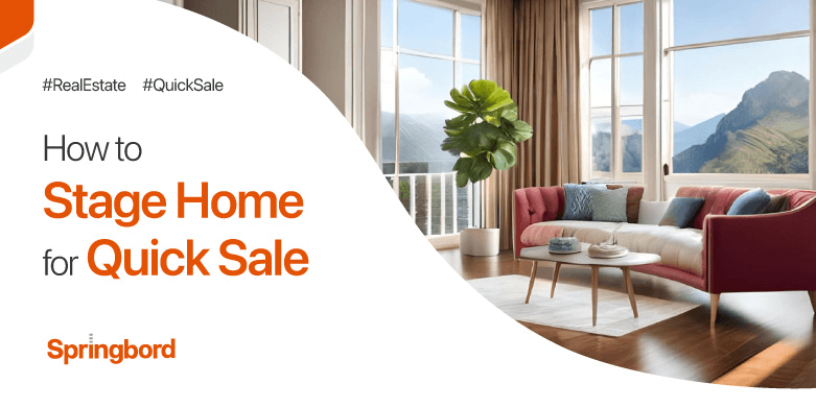 Read time 9 min
Read time 9 minStaging a home for quick sale is crucial in today’s competitive real estate market.
The process of stage home for quick sale involves strategically arranging and decorating the property to attract potential buyers and expedite the selling process.
A seller’s prospects of making a rapid and profitable sale are greatly improved when they have a firm grasp on the significance of staging properties for quick sale and employ efficient tactics. In this guide, we will delve into key strategies to stage home for quick sale, ensuring a lucrative outcome for sellers.
Understanding the Market
Understanding the real estate market is a crucial step in successfully staging a home for a quick sale. Making educated judgements that resonate with potential purchasers requires in-depth study and understanding of the local market situation.
With this level of insight, sellers may better target their staging efforts to the demographic of buyers most interested in their property.
- Research and analyse the local real estate market to identify current trends and buyer preferences:
Conduct market research and analysis of the local real estate sector to learn about the latest trends and the tastes of potential buyers: Data on recent transactions, available inventory, and pricing patterns can be gleaned by researching and assessing the local real estate market.
By looking at recently sold homes in the area, sellers can get an idea of what a reasonable asking price would be. The typical number of days a home is on the market before being sold can also be gleaned from this analysis, allowing prospective buyers to better plan their move.
In addition, knowing the property’s ideal clientele requires looking into the area’s demographics. People looking to buy a home have different tastes and requirements depending on the neighbourhood.
For instance, a suburban family-oriented community might appeal to families looking for spacious yards and good schools, while a trendy urban area might attract young professionals seeking proximity to entertainment and amenities.
- Emphasise the significance of knowing the target audience:
Beyond a generic method of staging, it is crucial to understand who you are performing for. Sellers who put some thought into who might be interested in purchasing their home can more effectively market the home to that audience.
Staging the home to highlight child-friendly rooms like a playroom or a fenced backyard, for instance, can be very beneficial if the intended buyers are young families. Empty nesters, on the other hand, might be more interested in the property’s low maintenance features and accessibility to recreational opportunities.
Staging that is tailored to the tastes of the intended customers is more likely to evoke positive feelings in them. Having this link increases the likelihood that they will buy quickly.
- Provide insights into the types of homes that tend to sell quickly due to effective staging:
Providing insights into the types of homes that tend to sell quickly due to effective staging offers valuable guidance to sellers. Sellers can increase their property’s value by catering to current tastes by including a few tried-and-true design trends.
Among the most sought-after characteristics in many real estate markets today are open floor plans, modern kitchens with updated appliances, and energy-efficient renovations.
Curb appeal is also important because it’s the first thing that visitors and potential buyers see. Having a well-kept façade, attractive landscaping, and a warm and inviting doorway can all help sell a home.
More potential buyers will be interested in purchasing a home with these desirable characteristics and curb appeal if they see that it has them.
Decluttering and Depersonalizing
Decluttering and depersonalising play a crucial role in preparing a home for a quick sale. These two aspects create a clean, spacious, and inviting atmosphere that appeals to potential buyers.
A. Importance of Decluttering:
Decluttering is the process of removing excess items and unnecessary possessions from a space. Buyers need to be able to picture themselves in a home when they go to look at it.
Clutter can detract from the beauty of a home and make it more challenging to sell. Remove any and all unnecessary items from the home to provide potential buyers a clearer view of the home’s layout and amenities.
A clutter-free space also gives the impression of a well-maintained and cared-for home. It tells potential purchasers that they can move in without much work and that the home is in fine shape.
Having additional space in a room is a major selling point, and that point is enhanced by decluttering. Overstuffing a place might make it appear smaller and less inviting.
B. Practical Tips for Organizing and Storing Belongings:
- Start Early: Start clearing out clutter well before you plan to sell the house. Going through everything and deciding what to retain, donate, and throw out could take more time than you anticipate.
- Room-by-Room Approach: If you’re afraid about being overwhelmed, start with one room at a time. Start with the spaces that see less foot traffic, like the basement, the attic, and the storage room.
- Declutter Personal Items: Reduce the amount of personal stuff you have on display, such as photos and keepsakes from your family. This aids prospective buyers in imagining themselves living in the home.
C. Emphasising Depersonalization:
Depersonalising a home involves removing items that reflect the current owner’s personal taste and style. Even if the buyer appreciates your tasteful additions, they must be able to see themselves in the home.
A home that has been depersonalised provides potential purchasers with a blank slate against which to envision their own furnishings, possessions, and memories.
- Neutralise Decor: First, make use of neutral colours when decorating and painting the walls. This makes for a setting that works well with a wider range of aesthetic preferences.
- Remove Personal Collections: Pack away any collections, unique artwork, or other items that may be too specialised to your tastes for the time being.
- Minimise Personal Memorabilia:
While a few decorative items like vases or simple artwork are fine, remove family photos, diplomas, and intensely personal things that could distract potential buyers.
Enhancing Curb Appeal
Enhancing curb appeal is a critical aspect of preparing a home for sale, as it greatly influences potential buyers from the very first impression. The exterior appearance sets the tone for what awaits inside, and a well-maintained and visually appealing facade can make a significant difference in attracting buyers.
A. Significance of Curb Appeal:
Curb appeal refers to the overall attractiveness of a property as seen from the street. It’s quite crucial since it draws in customers and makes them want to shop there instead of elsewhere.
An attractive facade tells potential buyers that the property has been well-maintained and is worth their time from the moment they pull up to the curb. Improving the property’s curb appeal can raise its perceived worth, providing sellers an edge and possibly hastening the sale.
B. Tips for Improving Exterior Appearance:
- Landscaping: Invest time in enhancing the landscaping. Remove unkempt shrubs, mow the lawn frequently, and replenish mulch in flower beds. You might give your front yard an instant facelift by planting brightly coloured flowers and plants.
- Exterior Painting: Second, take a look at the home’s exterior paint to see how it’s holding up. A new coat of paint can do wonders for reviving the look of anything. Choose earth tones that will appeal to the widest possible audience while also fitting in with the local area.
- Repairs and Maintenance: Third, perform repairs and maintenance on everything that seems worn. Repair any broken tiles, siding or roofing, and fill up any cracks in the driveway or walkway. A property with a well-kept facade inspires confidence that any underlying problems have been addressed.
C. Using Inviting Elements:
- Well-Maintained Front Door: First and foremost, a door that has been well-maintained because it is the home’s main point of entry. Maintain it in pristine shape and think about giving it a fresh coat of paint in a warm hue. Putting in a new doormat and shining up the hardware are also good ideas.
- Proper Lighting: Outdoor lighting that meets code not only makes a space safer at night, but it also makes it feel more welcoming. Stylish lighting fixtures should be installed close to the front door and along the walkways.
- Tasteful Decorations: Subtle and elegant decorations can offer character without taking over a room. Make your front porch more appealing by adding plant pots, a wreath, and a bench.
Furniture Arrangement and Home Staging Techniques
Furniture arrangement and home staging techniques are essential elements in presenting a property at its best to potential buyers. A well-thought-out arrangement can create a sense of flow and maximize space, making the home feel inviting and spacious.
A. Guidelines for Arranging Furniture:
- Clear the Clutter: First, clear the room before arranging the furnishings to provide the impression of light and airiness. Get rid of the extraneous things and furniture that are only taking up space.
- Consider Traffic Flow: Think about how people will be moving about the space and arrange the furniture accordingly. Don’t block any doors or passageways to keep the room from feeling closed in.
- Create Conversation Areas: Set up seating arrangements that foster conversation and group activities. Place furniture such that seats face one another to encourage conversation and make guests feel at home.
B. Using Neutral Color Palettes and Modern Decor:
- Neutral Walls: If you want potential buyers to be able to see themselves and their furniture in the space, painting the walls a neutral colour is an excellent first step. Rooms with neutral paint colours are also more spacious and airy.
- Timeless Furniture: Invest in furniture that will last a long time and is still stylish. Traditional pieces with simple silhouettes and neutral upholstery are always a safe bet when redecorating.
- Accent with Colour: Use colour as an accent by incorporating colourful accents like pillows, rugs, and artwork into your decor. This makes the room more interesting to look at without using garish colours.
C. Strategic Placement of Artwork and Decorations:
- Highlight Best Features: You can bring attention to your home’s high ceilings, huge windows, or other special features by strategically placing artwork and decorative items throughout the space.
- Symmetry and Balance: Place artwork on walls or mantles in a symmetrical fashion to create a sense of balance and harmony. Beautiful and peaceful environments can be made with well-balanced design.
- Reflect Light: Hang mirrors strategically to reflect natural light and make rooms feel more spacious and bright.
Final Touches and Marketing
Final touches and marketing are crucial aspects of the home-selling process that can make a significant difference in attracting potential buyers and achieving a quick sale. These final details add polish and finesse to the property while effectively marketing the home to a broader audience.
A. Tips for Adding Final Touches:
- Fresh Scents: Use candles or air fresheners with subtle fragrances to create a nice atmosphere. An unobtrusive aroma of warmth and welcome can make a memorable impression on guests.
- Soft Textiles: Throw blankets, pillows, and area rugs are all great examples of soft materials that can make a space feel more inviting. Buyers will love the cozy vibe you can achieve with these additions.
- Fresh Flowers: Place fresh flowers in vases throughout the home. Not only do they add a touch of color and beauty, but they also bring a sense of life and vibrancy to the space.
B. Significance of Professional Photography and Virtual Tours:
- First Impression: In today’s digital world, internet listings are often the first time potential buyers see a property. Having a professional take pictures of your home can guarantee that its best qualities are highlighted.
- Virtual Tours: Potential buyers can take a tour of the home without leaving their living room by using a virtual tour. As a result of this engaging experience, potential buyers will have a far better understanding of the home’s layout.
C. Benefits of Effectively Staging a Home for a Quick Sale:
- Faster Sale: One, a home can be sold more rapidly after being staged since its appeal is increased and it is more marketable.
- Higher Sale Price: A well-staged home is more likely to sell for a greater price since buyers will view it as more valuable and appealing.
- Competitive Advantage: Staging gives you an edge in a competitive real estate market by making your house stand out from the crowd and attracting more potential buyers.
To Sum Up
Staging a home is a powerful and successful technique for selling a home quickly in today’s real estate market. Tips and tactics for staging a property for a rapid sale are detailed in this article to help sellers increase their chances of finding a buyer, making a good first impression, and closing a deal.
Just as Springbord, a market leader in offering customised data solutions to a wide range of sectors, appreciates the value of individualization and attention to detail, house sellers who take the time to carefully consider their target audience and carefully stage their property for sale will find far more success in the marketplace.







